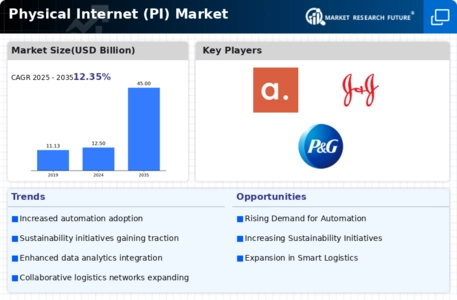North America : Leading Market Innovators
North America is poised to maintain its leadership in the Physical Internet Market, holding a significant market share of 5.0 in 2025. The region's growth is driven by advanced logistics infrastructure, increasing e-commerce demand, and supportive regulatory frameworks. The integration of technology in supply chain management is also a key catalyst, enhancing efficiency and reducing costs. As companies adapt to consumer needs, the market is expected to expand further, supported by investments in automation and digitalization.
The competitive landscape in North America is robust, featuring major players like FedEx, UPS, and DHL, which are continuously innovating to enhance service delivery. The U.S. leads the market, followed by Canada, with a focus on sustainability and efficiency. The presence of these key players fosters a dynamic environment, encouraging collaboration and competition. As the market evolves, companies are likely to leverage data analytics and AI to optimize operations, ensuring they meet the growing demands of consumers and businesses alike.
Europe : Emerging Logistics Hub
Europe's Physical Internet Market is projected to reach a size of 3.5 by 2025, driven by a strong emphasis on sustainability and regulatory support for green logistics. The European Union's initiatives to reduce carbon emissions and enhance supply chain transparency are pivotal in shaping market dynamics. As businesses adapt to these regulations, the demand for innovative logistics solutions is expected to rise, fostering growth in the sector. The region's commitment to digital transformation further accelerates this trend, making logistics more efficient and responsive.
Leading countries in Europe include Germany, France, and the Netherlands, where major logistics firms like DB Schenker and Kuehne + Nagel are headquartered. The competitive landscape is characterized by a mix of established players and emerging startups, all vying for market share. The presence of key players enhances collaboration and innovation, driving the market forward. As the region embraces new technologies, the Physical Internet Market is set to thrive, aligning with broader economic goals and consumer expectations.
Asia-Pacific : Rapidly Growing Market
The Asia-Pacific region is witnessing rapid growth in the Physical Internet Market, projected to reach 3.0 by 2025. This growth is fueled by increasing urbanization, rising e-commerce activities, and government initiatives aimed at enhancing logistics infrastructure. Countries like China and India are at the forefront, with significant investments in technology and infrastructure to support the burgeoning demand. Regulatory support for digital logistics solutions is also a key driver, enabling businesses to optimize their supply chains effectively.
China leads the market, followed by Japan and India, with major players like Nippon Express and XPO Logistics making significant inroads. The competitive landscape is vibrant, characterized by both local and international firms striving to capture market share. As the region continues to innovate, the integration of AI and IoT in logistics operations is expected to enhance efficiency and customer satisfaction, positioning Asia-Pacific as a formidable player in the global market.
Middle East and Africa : Emerging Logistics Frontier
The Middle East and Africa region is gradually emerging in the Physical Internet Market, with a projected size of 1.0 by 2025. This growth is driven by increasing investments in logistics infrastructure and a growing demand for efficient supply chain solutions. Governments in the region are actively promoting initiatives to enhance trade and logistics capabilities, which are crucial for economic development. The rise of e-commerce is also contributing to the demand for innovative logistics solutions, creating new opportunities for growth.
Leading countries in this region include the UAE and South Africa, where logistics firms are expanding their operations to meet the rising demand. The competitive landscape is evolving, with both local and international players entering the market. As the region embraces technological advancements, the Physical Internet Market is expected to grow, aligning with broader economic goals and enhancing connectivity across borders.
















